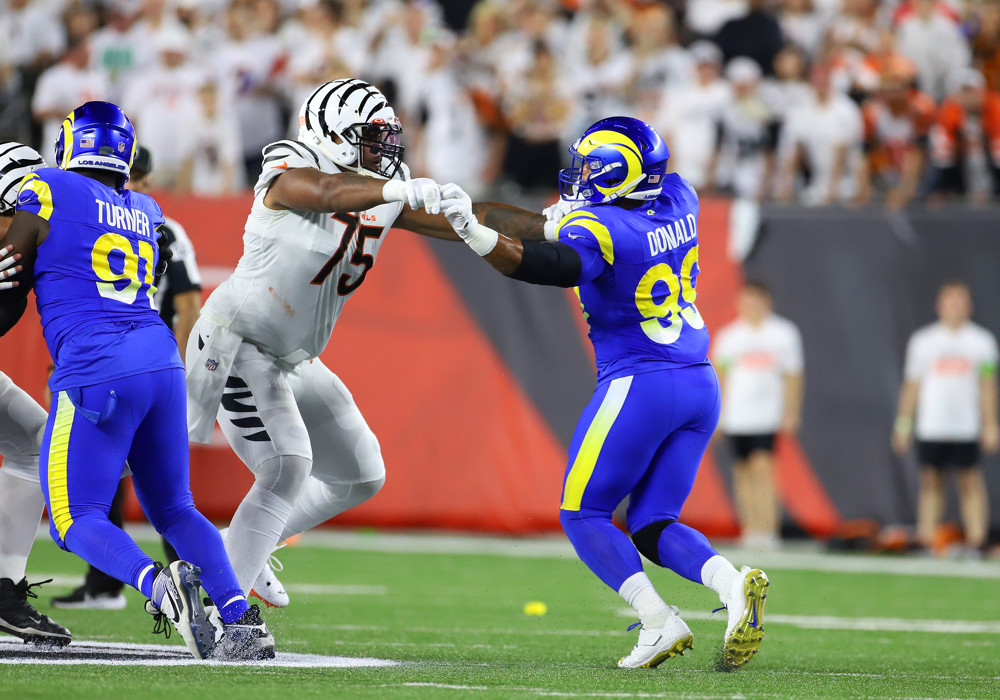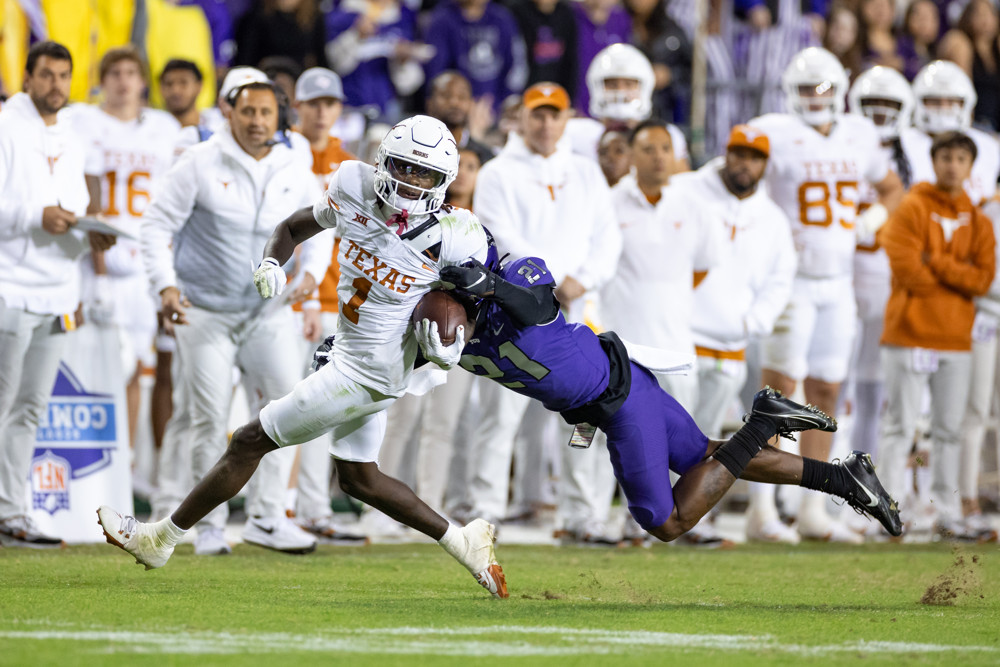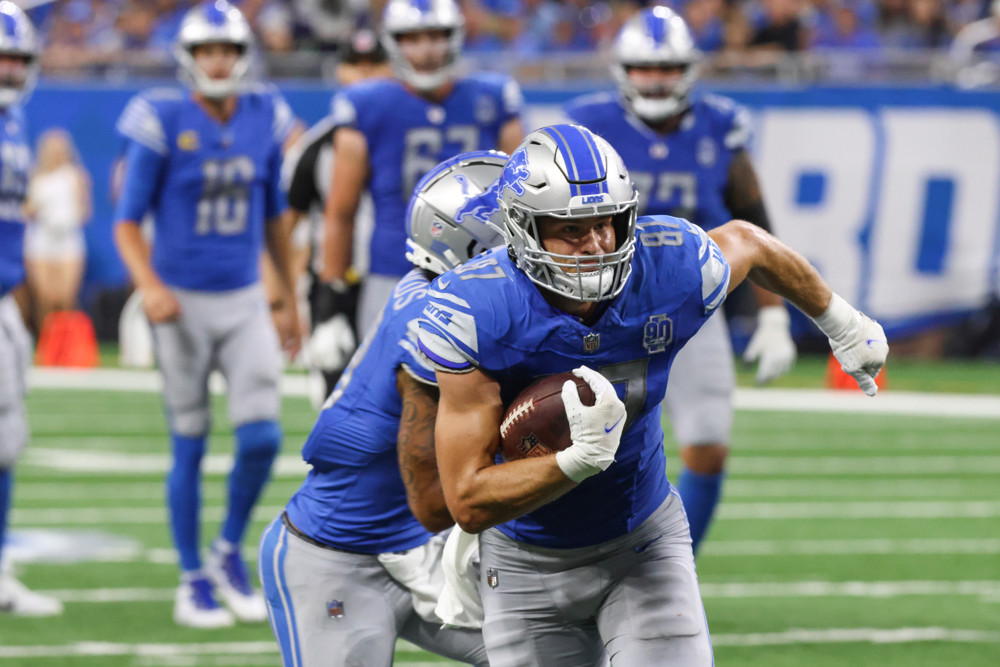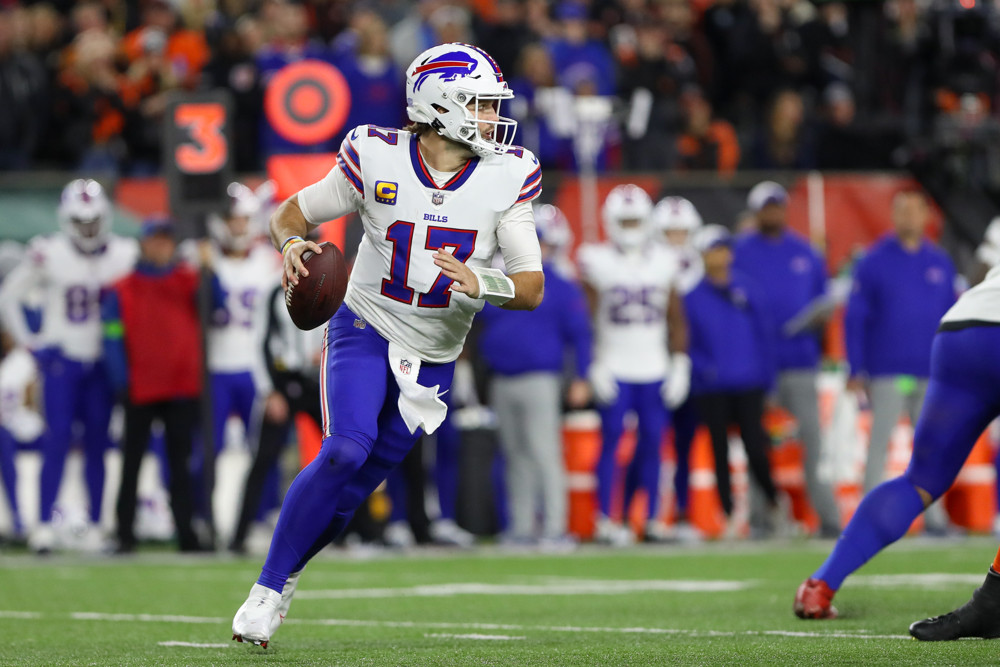
Let’s continue our look back at 1979 and 1980 DVOA ratings. Today we have player DVOA and DYAR from the 1979 season. It was a good year for the Cowboys, Chargers, and Patriots offenses. It was a very good year for Earl Campbell and the Houston Oilers running game.
A reminder, here’s the complete schedule for introducing 1979 and 1980 DVOA this week:
- Monday: 1979 team ratings
- Tuesday: 1979 player ratings
- Wednesday: 1980 team ratings
- Thursday: 1980 player ratings
- Friday: All 1979 and 1980 ratings will be added to downloads on the DVOA Historical Archives page.
As I noted yesterday, we were not able to find the entire 1979 season of play-by-play, so all of the 1979 numbers are missing the fourth quarter of the Week 1 Broncos-Bengals game and the final 4:47 of the Week 2 Cardinals-Giants game.
QUARTERBACKS
The top passer in both DYAR and DVOA was Roger Staubach, playing his final year for the Cowboys at age 37. Staubach led the NFL in adjusted net yards per attempt for three straight years from 1977 to 1979. The touchdown to interception ratio of 27 to 11 really stood out; that’s an interception rate of 2.4% and Ken Anderson (2.9%) was the only other quarterback under 3.0% as interceptions were a lot more common 45 years ago. Compare Staubach’s TD:INT ratio to the passer who finished second in DYAR, Dan Fouts. Fouts had the league’s highest completion rate and the most total yards but had 24 interceptions to go with 24 touchdowns. Plus, Fouts gets moved down a bit because of an easy schedule, whereas Staubach and especially No. 3 Jim Zorn move up a bit because of harder schedules.
However, Staubach was dead last in rushing DYAR at -48, carrying the ball 31 times for 177 yards. He fumbled twice in a Week 4 game against Cleveland, a failed quarterback sneak from the Cleveland 2 and then an 11-yard scramble around midfield. Somehow, Staubach only converted two out of five quarterback sneak attempts.
Ken Anderson was No. 1 in rushing DYAR at 111 followed by Joe Theismann at 105 and Jim Zorn at 75. It wasn’t a big year for quarterback runs and Steve Grogan was the only quarterback with more than 300 rushing yards.
Here were the top 10 quarterbacks of the year by passing DYAR:
| Top 10 in Passing DYAR, 1979 | |||||||||||
| Player | Team | DYAR | Rk | DVOA | Rk | Pass | Yds | TD | INT | C% | NY/P |
| R.Staubach | DAL | 1,489 | 1 | 37.2% | 1 | 499 | 3,343 | 27 | 11 | 57.9% | 6.70 |
| D.Fouts | SD | 1,100 | 2 | 19.6% | 3 | 568 | 3,863 | 24 | 24 | 62.5% | 6.80 |
| J.Zorn | SEA | 1,047 | 3 | 21.1% | 2 | 530 | 3,444 | 20 | 17 | 56.7% | 6.50 |
| T.Bradshaw | PIT | 872 | 4 | 16.6% | 5 | 503 | 3,503 | 26 | 25 | 54.9% | 6.96 |
| K.Stabler | OAK | 853 | 5 | 13.6% | 7 | 538 | 3,291 | 26 | 22 | 61.0% | 6.12 |
| J.Theismann | WAS | 787 | 6 | 18.2% | 4 | 429 | 2,521 | 20 | 13 | 59.4% | 5.88 |
| S.DeBerg | SF | 733 | 7 | 7.6% | 10 | 599 | 3,527 | 17 | 20 | 60.0% | 5.89 |
| J.Ferguson | BUF | 693 | 8 | 12.5% | 8 | 502 | 3,184 | 14 | 15 | 52.0% | 6.34 |
| A.Manning | NO | 676 | 9 | 14.5% | 6 | 440 | 3,025 | 15 | 20 | 59.9% | 6.88 |
| B.Sipe | CLE1 | 636 | 10 | 6.4% | 11 | 581 | 3,438 | 28 | 26 | 53.7% | 5.92 |
Some hidden stats that contributed to these rankings: Kenny Stabler gained 202 yards on DPI flags, while Doug Williams (17th in DYAR), Steve DeBerg, and Archie Manning were the top three quarterbacks with the lowest sack rates.
At the bottom of the league in passing DYAR were three rookies who had very different career paths after 1979.
Jeff Komlo (-529 DYAR) was a ninth-round pick out of Delaware who was supposed to be Detroit’s third-string quarterback. But Gary Danielson was injured in the preseason and then veteran backup Joe Reed got hurt late in Week 1. Komlo ended up starting 14 games in the 1979 season, completing less than half his passes with 11 touchdowns and 22 interceptions. Danielson was healthy again in 1980 and Komlo only started two more NFL games in 1981.
Phil Simms (-429 DYAR), on the other hand, was a high draft pick — although a surprising one. Nobody expected Simms to go in the first round out of Division I-AA Morehead State but the Giants took him with the seventh overall pick. In the modern world of social media, Simms’ rookie year would have featured what we call “discourse.” The Giants started 0-5 before head coach Ray Perkins put Simms in as the starter. Simms then won his first four games in a row and ended up with the Giants going 6-5 in his starts. But Simms just wasn’t very good despite that record. He barely completed half his passes, taking a lot of sacks and throwing interceptions on more than 5.0% of his attempts against an easy schedule. Simms finished second in the Rookie of the Year balloting behind running back Ottis Anderson despite his poor numbers. After a few years of struggling with injuries, things finally got better for him around 1984.
Steve Fuller (-393 DYAR) was also a first-round pick, 23rd overall to Kansas City. He threw for just 5.5 yards per attempt in 12 starts but the Chiefs went 6-6 in those games thanks to top 10 defense and special teams. Fuller started 13 games the next year, then lost his job as Kansas City starter to Bill Kenney. After a year with the Rams where he didn’t play, he ended up in Chicago as a backup to Jim McMahon during those Bears glory years of 1984-1986.
A couple of other quarterbacks you might be curious about, with passing DYAR:
- Ken Anderson, Bengals: 446 DYAR (12th)
- Ron Jaworski, Eagles: 223 DYAR (19th)
- Dan Pastorini, Oilers: -333 DYAR (25th)
RUNNING BACKS
Earl Campbell was a force of nature, leading the NFL in rushing yardage in his first three seasons (1978-1980). Talking about Campbell’s 1979 season means also talking about his 1980 season, so you’re going to get a little bit of a preview of the 1980 numbers here as well.
Campbell rushed 368 times for 1,697 yards and 19 touchdowns in 1979, winning the Associated Press MVP award. That set the NFL record for carries in a season. Then Campbell broke that record and was even better in 1980, rushing 373 times for 1,934 yards and 13 touchdowns. He led the NFL in both total yards and yards per carry that year. Campbell did this against a harder than average schedule in both seasons. Remember, he played in the same division as the Pittsburgh Steelers so he faced them twice a year, and that was the best run defense of 1979. Campbell faced top-six run defenses in five different games that season.
Campbell had 539 rushing DYAR in 1979 and then 649 rushing DYAR in 1980. Nobody else was above 300 rushing DYAR in either year. Those numbers give Campbell two of the top five seasons in rushing DYAR history, with the 1980 season very narrowly coming in behind Terrell Davis’ 1998 season for the top spot.
| Top RB Rushing DYAR Seasons, 1979-2023 | ||||||||
| Player | Team | Year | DYAR | DVOA | Runs | Yards | TD | Suc% |
| T.Davis | DEN | 1998 | 652 | 29.0% | 392 | 2,008 | 21 | 52% |
| E.Campbell | HOIL | 1980 | 649 | 31.5% | 373 | 1,934 | 13 | 58% |
| T.Davis | DEN | 1997 | 541 | 25.3% | 369 | 1,743 | 15 | 56% |
| E.Smith | DAL | 1995 | 540 | 23.6% | 377 | 1,773 | 25 | 53% |
| E.Campbell | HOIL | 1979 | 539 | 24.2% | 370 | 1,700 | 19 | 57% |
| S.Davis | WAS | 1999 | 531 | 32.8% | 290 | 1,405 | 17 | 60% |
| P.Holmes | KC | 2003 | 513 | 27.1% | 320 | 1,420 | 27 | 58% |
| P.Holmes | KC | 2002 | 513 | 29.3% | 313 | 1,615 | 21 | 55% |
| J.Taylor | IND | 2021 | 511 | 25.3% | 332 | 1,811 | 18 | 56% |
| L.Johnson | KC | 2005 | 488 | 24.1% | 335 | 1,741 | 20 | 55% |
| L.Tomlinson | SD | 2006 | 460 | 23.1% | 347 | 1,813 | 28 | 49% |
| A.Peterson | MIN | 2012 | 458 | 24.9% | 348 | 2,097 | 12 | 49% |
However, Campbell was a terrible receiving back. He had -70 receiving DYAR in 1979, catching just 16 passes out of 25 targets for 94 yards with no touchdowns.
Cleveland fullback Mike Pruitt finished second in rushing DYAR and Chicago legend Walter Payton was third. Payton had almost as many carries and yards as Campbell but a much lower success rate against an easier schedule. Larry Cosnka was fifth in DYAR in his final NFL season and Rookie of the Year Ottis Anderson was sixth, partly because he had 10 fumbles.
| Top 10 RB in Rushing DYAR, 1979 | |||||||||
| Player | Team | DYAR | Rk | DVOA | Rk | Runs | Yards | TD | Suc% |
| E.Campbell | HOIL | 539 | 1 | 24.2% | 1 | 370 | 1,700 | 19 | 57% |
| M.Pruitt | CLE1 | 292 | 2 | 15.5% | 8 | 264 | 1,294 | 9 | 57% |
| W.Payton | CHI | 265 | 3 | 8.7% | 13 | 369 | 1,610 | 14 | 50% |
| C.Muncie | NO | 260 | 4 | 17.2% | 4 | 238 | 1,198 | 11 | 53% |
| L.Csonka | MIA | 255 | 5 | 16.7% | 5 | 220 | 837 | 12 | 56% |
| O.Anderson | STLC | 246 | 6 | 9.1% | 12 | 331 | 1,605 | 8 | 49% |
| C.Gaines | NYJ | 237 | 7 | 24.0% | 2 | 186 | 902 | 0 | 54% |
| S.Smith | SEA | 203 | 8 | 16.4% | 6 | 194 | 775 | 11 | 47% |
| P.Hofer | SF | 185 | 9 | 23.3% | 3 | 124 | 620 | 7 | 59% |
| M.van Eeghen | OAK | 175 | 10 | 8.5% | 14 | 223 | 818 | 7 | 55% |
Tampa Bay rookie third-round pick Jerry Eckwood was last in rushing DYAR. He gained just 3.6 yards per carry with nine fumbles on 195 carries and a 31% success rate.
Wilbert Montgomery of the Eagles had 338 carries for 1,512 yards and nine touchdowns but ranked 27th with just 67 rushing DYAR because of a very easy schedule (he was 16th in YAR without opponent adjustments) and a league-leading 12 fumbles.
Other running backs you might be curious about:
- Tony Dorsett, Cowboys: 113 rushing DYAR (19th)
- Franco Harris, Steelers: 68 rushing DYAR (26th)
- O.J. Simpson, 49ers: 11 rushing DYAR (42nd, his final season)
As for receiving numbers, they were big for the Baltimore Colts running backs. Don McCauley led all running backs with 248 receiving DYAR, catching 55 passes for 575 yards and three touchdowns. Joe Washington was even more active in the receiving game, with 110 targets. He caught 82 passes for 759 yards and three touchdowns, and finished fourth with 169 receiving DYAR.
Washington’s Clarence Harmon was second in DYAR behind McCauley despite only 46 targets. He caught 32 of them for 434 yards (13.6 yards per reception) and five touchdowns. That was worth 79.1% DVOA, the fourth-highest receiving DVOA ever for a qualifying running back (more than 25 targets). Other running backs who were strong receiving included Seattle’s Sherman Smith, Oakland’s Mark van Eeghen, and San Francisco’s Paul Hofer.
New England’s Don Calhoun was last in receiving value, catching just 15 of 30 targets for 66 yards and a touchdown.
WIDE RECEIVERS
We’ve got four wide receivers grouped at the top of the DYAR table for 1979, and the top four players in DYAR were also the top four qualifying wide receivers (50 or more targets) in DVOA. Twelve-year veteran Harold Jackson from the Patriots was on top with both 342 DYAR and 39.2% DVOA. Drew Pearson of the Cowboys was then second in both stats with 338 DYAR and 32.6% DVOA. John Jefferson of the Chargers was third and Steve Largent of the Seahawks was fourth. As befits the two best offenses of the year, the Cowboys and Chargers each had two receivers in the top six, with Tony Hill fifth and Charlie Joiner sixth. Here are the top 10 wide receivers by DYAR:
| Top 10 WR in Receiving DYAR, 1979 | |||||||||||
| Player | Team | DYAR | Rk | DVOA | Rk | Rec | Pass | Yds | TD | Yd/C | C% |
| H.Jackson | NE | 342 | 1 | 39.2% | 1 | 45 | 84 | 1,012 | 7 | 22.5 | 54% |
| D.Pearson | DAL | 338 | 2 | 32.6% | 2 | 55 | 97 | 1,024 | 8 | 18.6 | 57% |
| J.Jefferson | SD | 325 | 3 | 26.3% | 3 | 61 | 110 | 1,090 | 10 | 17.9 | 55% |
| S.Largent | SEA | 324 | 4 | 23.5% | 4 | 66 | 119 | 1,237 | 9 | 18.7 | 55% |
| T.Hill | DAL | 289 | 5 | 20.2% | 6 | 60 | 116 | 1,062 | 10 | 17.7 | 52% |
| C.Joiner | SD | 268 | 6 | 15.6% | 7 | 72 | 118 | 1,008 | 4 | 14.0 | 61% |
| S.Morgan | NE | 253 | 7 | 23.0% | 5 | 44 | 94 | 1,002 | 12 | 22.8 | 47% |
| D.Logan | CLE1 | 216 | 8 | 13.4% | 10 | 59 | 110 | 982 | 7 | 16.6 | 54% |
| F.Lewis | BUF | 205 | 9 | 14.6% | 9 | 54 | 106 | 1,082 | 2 | 20.0 | 51% |
| R.Upchurch | DEN | 197 | 10 | 12.2% | 11 | 63 | 101 | 918 | 7 | 14.6 | 62% |
At the bottom of 52 qualifying wide receivers were two wideouts from the St. Louis Cardinals, Mel Gray and Dave Stief. Gray was a veteran in his ninth season, not to be confused with the younger running back and kick returner from the early 90s Lions, while Stief was a second-year receiver who was a 1978 seventh-round pick out of Portland State.
Some other ranks in DYAR for well-known wide receivers:
- John Stallworth, Steelers: 187 DYAR (11th)
- Ahmad Rashad, Vikings: 187 DYAR (12th)
- Harold Carmichael, Eagles: 177 DYAR (14th)
- Lynn Swann, Steelers: 145 DYAR (20th)
- James Lofton, Packers: -46 DYAR (46th)
TIGHT ENDS
It wasn’t a big year for tight ends in 1979. The top tight end in DYAR was Henry Childs of the Saints, in his sixth season out of Kansas State. Keith Krepfle of the Eagles was second in DYAR. Eleven-year veteran Bob Klein of the Chargers, in his final season, led qualifying tight ends (min. 25 targets) in DVOA at 40.6% and was fourth in DYAR. Here are the top 10 tight ends by DYAR:
| Top 10 TE in Receiving DYAR, 1979 | |||||||||||
| Player | Team | DYAR | Rk | DVOA | Rk | Rec | Pass | Yds | TD | Yd/C | C% |
| H.Childs | NO | 207 | 1 | 37.8% | 2 | 51 | 75 | 846 | 5 | 16.6 | 68% |
| K.Krepfle | PHI | 189 | 2 | 35.7% | 3 | 41 | 76 | 760 | 3 | 18.5 | 54% |
| R.Chester | OAK | 167 | 3 | 22.2% | 10 | 58 | 89 | 712 | 8 | 12.3 | 65% |
| B.Klein | SD | 145 | 4 | 40.6% | 1 | 37 | 47 | 424 | 5 | 11.5 | 79% |
| P.Coffman | GB | 143 | 5 | 23.0% | 8 | 56 | 77 | 711 | 4 | 12.7 | 73% |
| B.Cunningham | PIT | 136 | 6 | 30.4% | 5 | 36 | 55 | 512 | 4 | 14.2 | 65% |
| R.Odoms | DEN | 119 | 7 | 22.9% | 9 | 40 | 66 | 638 | 1 | 16.0 | 61% |
| O.Newsome | CLE1 | 119 | 8 | 11.4% | 13 | 55 | 101 | 781 | 9 | 14.2 | 54% |
| J.Giles | TB | 111 | 9 | 14.9% | 12 | 40 | 81 | 579 | 7 | 14.5 | 49% |
| D.Warren | WAS | 95 | 10 | 35.5% | 4 | 26 | 36 | 303 | 0 | 11.7 | 72% |
Kellen Winslow, in his rookie year for the Chargers, had just 255 receiving yards and finished 23rd at -5 DYAR.
Kansas City’s Tony Samuels finished last in DYAR and DVOA, catching just 14 of 34 passes for 147 yards and no touchdowns.




























